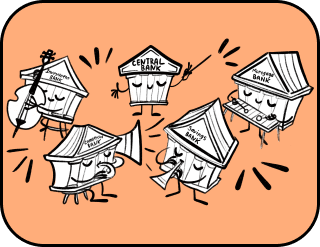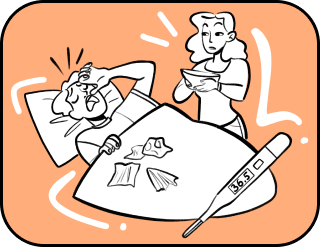The secrets of cryptography: from Casanova to the Voynich manuscript
‘Come on, show it to him!’
‘Here,’ said the boy of about ten, holding out a crumpled piece of paper to his friend.
His friend fixed his glasses, straightened the crumpled sheet, and even sniffed it for some reason.
‘Well, it’s all clear to me,’ he said gravely, ‘She loves you.’
‘What makes you think that?’ Another boy in short school pants asked suspiciously. This boy had a strange way of dressing, as if he was deliberately wearing things that were several sizes smaller. Every awkward movement was accompanied by a dry characteristic cracking sound “cruuuunch”, which showed that the clothes were ready to tear at any moment. He also always carried an empty wooden box with him.
‘Yeah, what makes you think that?’ cautiously asked the young man who was the owner of the unfortunate piece of paper.
‘Well, it’s here, here! It’s all clearly written here!’ The young man with glasses was indignant and tapped the piece of paper with the message on his hand.
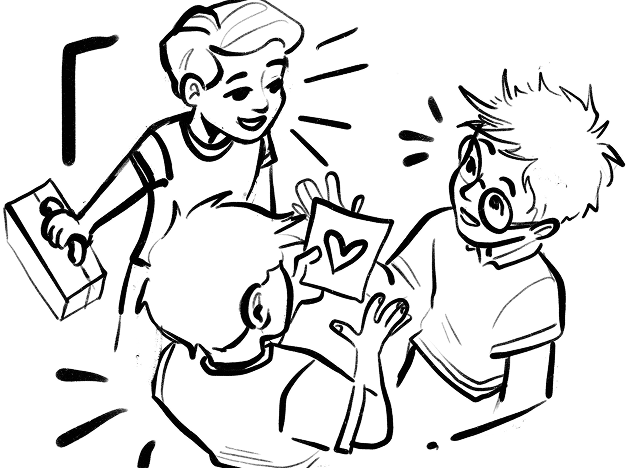
‘Give it to me!’ commanded the guy in short pants and snatched the paper out of his friend’s hands. ‘It doesn’t say anything! There’s just a simple heart drawn here.’
‘You don’t understand much!’ The young man frowned and turned away.
All of the friends of this young man called him Nim. Nim had once invented this nickname himself by combining the first letters of his first and last name, and he was very proud of his encrypted nickname. And Nim was also proud of the fact that he was the owner of real estate which was a garage given to him at his full disposal by his parents. Few of his friends could boast of the same. There he neatly arranged rusty nuts, parts from dismantled radios, moved all the junk from old attics there and put nine issues of his favorite Computer Bild magazine in the most prominent place.
Nim loved to read and conduct experiments – inventing smokeless gunpowder, testing the heat resistance of porcelain cups on the gas stove and setting up ground connections through wire-tied batteries. His parents were not always happy with the outcome of his experiments, so they gave him a separate garage. Better let him invent there.
‘What is there to understand if nothing is clear?’ The guy wearing the wrong sized clothes intervened in the conversation again. ‘It’s just a sheet of paper with a heart-shaped scribble on it.’
‘A heart-shaped scribble,’ Nim mocked him. ‘Let it be known to you that this is a real cipher, a hidden message that you and I have to unravel.’
He decided to shake hands with his friends, as scientists do after they have made a discovery, but hesitated when he saw the astonished looks of his friends.
‘But what could it be hiding?’ Cautiously asked the quiet young man.
‘A heart? Anything. Going to the movies, lavender raff, dissecting frogs together, exchanging pleasantries, recognition, concern, and even admiration.’
The quiet young man stepped aside and pondered. ‘Could there really be a whole world hidden in such a small symbol? Well, let’s say this symbol hides care, what do we know about it? I love my dog and that’s why I take care of him – I walk him on a leash, feed him different special canned food and let him roll around in the dirt. Does this heart tell me that someone wants to put me on a leash too, so they can walk me on schedule? And the admiration…’ The young man looked at himself carefully from head to toe, ‘There’s nothing supernatural about me. I don’t have a cool jacket like high school students, I don’t play soccer, I don’t set records. I don’t even have my own garage to experiment in. Maybe Nim was wrong, and this drawing doesn’t really mean anything.’
The quiet young man looked at his friends.
‘We have to find out what this heart is hiding,’ he said in a tone that did not tolerate any objections.
‘And how will you do that, I wonder?’ The guy wearing the short pants asked him with a smirk. ‘Will you go to the laboratory with this paper, examine the ink, take samples of the DNA, which may have been left by the person who wrote it, and conduct a handwriting examination?’
‘Why?’Nim responded instantly, ‘You and I will turn to cryptography for the clue.’
‘Now he’s going to start telling us his fairy tales,’ the guy with the box objected unhappily. ‘He’s made up some nonexistent word and thinks we’ll believe him right away.’
‘I haven’t made it up!’ Nim, feeling insulted, objected to his buddy. ‘Cryptography is an ancient science, which can be practiced only by the chosen and inquisitive, by those who like to solve riddles. It dates back to a time when people didn’t know how to talk. Let’s go to my garage, there we’ll figure it all out.’
The quiet young man nodded and looked at his friend. He sighed unhappily, picked up the empty box from the ground and muttered through his teeth, ‘Okay. Let’s go solve the riddle of the drawn heart.’
Chapter one. Humans mumbled cryptography
As soon as the two boys stepped over the threshold of the garage, Nim immediately started bustling.
‘Where the hell is it? Oh, it’s here,’ he said, flipping through the magazines spread out on the table. ‘And here. And this will come in handy too.’
Nim took some books out of his knapsack, then he rummaged in a dusty corner between the boxes on the floor and a bucket of liquid and took out a metallophone, but without sticks. Then he took a magnifying glass out of the toolbox and put on the cloak hanging on the door, which instantly made him look like a mad stargazer.
Nim’s friends. who couldn’t understand anything, watched Nim’s actions in silence and occasionally glanced at the spiders, who nervously watched the actions of the young garage owner from where they were.
Finally Nim took out all the necessary items and placed them on the table.
‘So,’ he began from afar, ‘What do we know about encryption?’
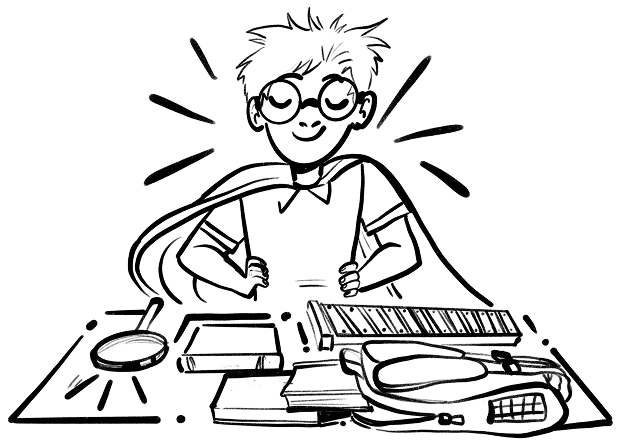
‘It came about thanks to spies,’ the boy with the strange way of dressing boldly said. ‘“Bond, we need to hide this letter. Nothing is easier – we’ll use a substitution cipher, sympathetic ink, and disguise the letter itself as a bush.” Or the famous “Alex to Eustace, Alex to Eustace.”’
‘That’s the first mistake,’ stated satisfied Nim, taking the magnifying glass from his friend’s hands. ‘Encryption appeared long before there were spies and your famous Mr. Bond. Look here!’
The boys obediently looked at the picture the young man put in front of them. The picture showed some low mountains. At the foot of one of the mountains sat a man, wrapped in the skin of a spotted beast, who was making a fire. From behind the mountain which was behind his back, smoke was rising into the sky, making it clear that someone else was making the same fire.
‘Well?’ Nim asked, pointing his finger at the picture.
‘What?’ his buddies asked in one voice, understanding nothing.
‘Can you see the encryption?’ Nim persisted.
The guys looked at the picture confusedly.
‘Should we see a secret word here?’ the quiet young man suggested squinting.
‘Or is there a bear hiding behind that rock over there?’ giggled another friend.
Nim paced the room unhappily. He thought the process of mastering encryption would be much easier.
‘No!’ he said loudly, ‘Don’t you see the fires in the picture?’
‘Yes, we do!’ replied the boys in unison.
‘This is encryption!’ Nim concluded unequivocally.
Realizing that his friends were completely confused, he replaced anger with mercy and decided to explain everything.
‘As I said, ancient people could not speak, they had only a limited set of sounds available to them. And the set of those sounds was different for everyone – someone came into close contact with animals and imitated sounds similar to growls or howls. Someone’s speech apparatus was too poorly developed, so such a person could only mumble. But most importantly, the people of the ancient world had no…’
‘Toilet!’ shouted out one of the young men, but immediately faltered under the stern gaze of the “improvised teacher”.
‘Most importantly, the people of that time had no need for communication. A man lived like this: he was born, lived to a certain point and died, either from a simple infection, or from the paws of an animal, or from the bite of a poisonous fish or snake, or from the bite of an ordinary mosquito. There was no time for ancient people to communicate or make friends. But, as soon as man managed to realize that you can stay on earth a little longer, if you get food with the help of devices and lead a safer way of life, evolution relented and gave people the need for communication.’
‘And how did they start talking?’ a more modest friend asked with interest.
‘They didn’t,’ answered Nim who knew it. ‘The question is: How did they begin to understand each other? And that is where cryptography came to help them in the form of signals: sounds and fire. One man was beating loudly in a vat covered with leather, another man heard it and instantly deciphered it – I HAVE A BAD MORNING TODAY, O FRIEND THERE IS A BIG PREDATORY BEAST IN MY SHELTER. And in the language of symbols people were able to communicate almost without collusion, everyone understood what the drums were saying. And in this picture two fires represent a piece of encrypted speech. That’s what ciphers are: speech, symbols and language so that you and I could understand each other now.’
‘And then people began to communicate with each other by means of speech?’ the quiet young man asked again.
‘At first with sounds. Then, for better communication, people began to combine these sounds so that the mumling became more conscious. But there was a new problem,’ Nim scratched behind his ear, ‘People didn’t know how to name things. They could describe a phenomenon for hours, but they didn’t have a name for any phenomenon.’
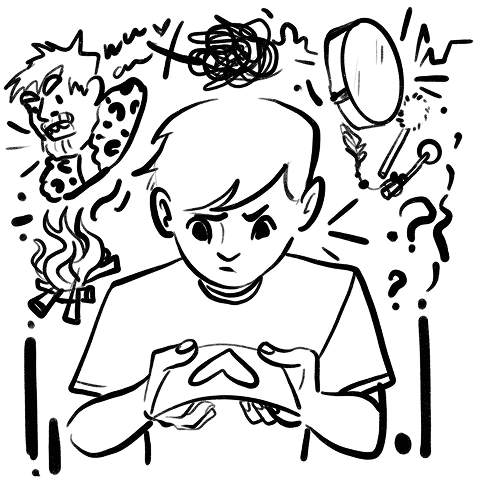
‘And then cryptography came to the rescue,’ the guy in short pants winked at Nim and put glasses on his nose to look more like a cryptography professor.
‘That’s right,’ Nim continued without noticing the sarcasm. ‘People began to learn to combine many words into one concept, roughly speaking, they learned to encrypt the meaning of speech. And only after that letters and the alphabet appeared. By the way, the famous double sounds in some languages also appeared thanks to encryption, though much later than the alphabet itself. For example, Eszett (ß) from German is a ligature of ſʒ (ſz; in Gothic script) or ſs (in Antiqua), the first element of which is the so-called long S.
The untalkative young man looked again at the sheet of paper with the drawn heart. Is there really some meaning or signal hidden in the symbol of two curlicues? But why? After communicating through fires and drums, people switched to words to communicate something to each other. Why would anyone want to send me a symbol?
His thoughts were interrupted by another friend.
‘Nim, we’ve realized that cryptography existed a long time ago, and thanks to it we learned how to communicate. But if we have learned to communicate, then cryptography should disappear. And then, how will it bring us closer to solving our mystery? Maybe we should go to someone who knows a thing or two about girlie messages.’
‘Exactly!’ the quiet friend said lively. ‘Remember, we were told in history class about an Italian adventurer – the writer Giacomo Casanova? He certainly wouldn’t speculate like we do. He must have known all the secrets that girls keep from us. Nim, do you know anything about him?’
‘I do,’ he said dryly, ‘but you won’t like it.’
Chapter Two. Mankind’s greatest deception or a seductive spy
‘Read it!’ Nim commanded and held out an old, yellowed sheet of newspaper torn from somewhere.
‘Some microorganisms have been in space,’ read the young man wearing short clothes.
‘You’re the one with the microorganism brain!’ Nim was angry with him, ‘Turn the sheet over.’
On the back side of the sheet of paper there was a portrait of a medieval man wearing rich robes and a wig. Above the portrait a headline said: “Mankind’s greatest deception or a seductive spy.”
‘Now we are talking!’ The buddy got excited and started reading. ‘The Casanova parents were actors from Venice, a city whose inhabitants knew a lot about entertainment. Young Giacomo lost his father early, his mother used to endlessly tour with a theater troupe, so the boy was taken to his grandmother. And later he was given Abbot Gozzi to be brought up by him. Casanova was a bright young man and already at the age of 12 entered the University of Padua: there he also manifested his extraordinary interest in women. Casanova led a wild lifestyle, but at the same time he graduated from the University with flying colors and moved to Paris. In Paris, he instantly became a favorite of all the nobility, he favored even the Marquise de Pompadour. It was there that he met the then-famous magician Cagliostro.’
‘And what does it give us?’ the modest young man said disappointedly.
‘The most interesting part will be further,’ Nim assured him and with a nod of his head told the young man in strange clothes to read on.

‘In Paris, Casanova met a rich lady – the Marquise d’Urfe, and they began a relationship of trust. One day the Marquise wrote a letter and gave it to Casanova to give it to the addressee. Casanova, being a curious young man, opened the letter and saw there was a piece of paper with a strange, cipher-like content. He had a couple of days to read the message – he analyzed the frequency of use of letters and length of coded words from which he found the key word, with the help of which the Marquise made a cipher. He immediately shared his achievement with the Marquise. True success in deciphering revealed the cynical side of Casanova – he immediately realized that he could get anything he wanted from his rich companion, if he explained his abilities as a mystical gift. “I could have told her the truth, but it occurred to me to declare that the key to deciphering the secret message was communicated to me by the Spirit. By this false confession I enslaved Mistress d’Urfe. She surrendered her soul to me that day, and I abused my power.”’
After this information the pals whistled altogether. They had heard the phrase “If you own the language, you own the world” before, but at that moment it played out in different colors.
‘The thing the Marquise certainly did not know was that encryption was a compulsory course at the Universities of Italy and France, because these countries were on the threshold of revolution,’ summarized Nim in the voice of a spy. ‘The Ministry of Foreign Affairs of France developed a cipher system called petits chiffres (“small codes”), in which words were replaced by numbers and historians say that Casanova knew it. This system initially had 600 characters under which 600 words were hidden, then this number was increased to 1200. Then Napoleon came to power and it seemed that this number of words was not enough for safe exchange of encrypted messages, because the British cracked the cipher literally in a few days. And only in 1811 France created a new code, which was called the Great Paris Cipher. But this cipher also turned out to be unstable: it was cracked by the British genius of decryption – the officer George Scovell, who immediately realized that it was necessary to study unencrypted messages to understand what words most often appeared in coded texts.’
After these words, the modest young man became visibly saddened. He looked again at the sheet with the drawn heart.
‘It turns out that in love, as well as in war people resorted to deception? So I was so happy to get this message for nothing. It doesn’t bode well.’
‘You’ve got a lot of nerve, Brother,’ Nim said, ‘Who knows what those girls have in mind?’
Chapter Three. The Kama Sutra Ciphers
‘What a find!’ came the voice of their friend from somewhere in the darkness, ‘A book in which everyone is naked!’
Nim and his quiet friend looked at each other puzzled. They had completely forgotten about their strange buddy, who was meanwhile scrutinizing the garage. The whole cryptography thing didn’t interest him much, so he walked between the shelves and looked at some iron pieces, trying to find something interesting. And then a lantern caught his eye. It was black, lacquered and with a huge lens. The whole city could be illuminated with such a lantern! But here was the trouble: this lantern was lying on the topmost shelf, which not every adult could reach, not to mention a ten-year-old child in inappropriate clothes.
Then the young man took an empty box, which he always carried with him, put it on a rib and deftly crawled up. When the coveted lantern was already in his hands, the box staggered and toppled the young man to the floor. Not only did he hurt his knee, but he was also covered with some books, one of which was the one where all the people were naked.
‘Are you coming or not?’ He called out to his buddies again.
Nim and the owner of the secret note hurried out.
The friends stared at the book in silence. There were many pictures of people who resembled men and women, but they seemed very fake: flat faces, elongated limbs, unnaturally curved bodies. And the person who drew them had obviously messed up the proportions and colors – the women were small and red, and all the men had a tuft of hair on their heads.
‘What is this strange book?’ Suspiciously, inquired the young man who had found it.

‘I can guess where it came from,’ said Nim, embarrassed, ‘I’ve seen it in the house before, but my parents strictly forbade me to touch it. Then they must have hidden it here and forgotten about it.’
‘And they did the right thing,’ said the quiet friend, ‘It’s disgusting. You can’t even read the text in this book.’
‘It must be some kind of cipher, too,’ said the young man in short clothes with a grin.
‘And I know what this book is, but I will tell you about it only when you tell me what you’re up to,’ the friends heard the voice of a neighbor girl, who was watching with interest what was happening in the garage through the open door.
‘There goes the day,’ Nim said unhappily.
‘Girls don’t belong here!’ supported his buddy, the owner of the empty box.
‘Whatever,’ the girl said resentfully and headed for the exit.
She was stopped at the door by the young man who had received the unfortunate note with the heart.
‘Please, don’t go. You’re just in time when we need your help.’
He showed the note to the girl and told her what they had already learned about cryptography. It seemed to him that it was the girl who should know why such messages were sent and what was encrypted in them.
‘All right, I’ll help you,’ the girl responded and took the book in her hands, ‘But you must not tell anyone about what you are about to learn from me. It’s a secret.’
‘Why would we…’ the young man in short clothes began to say, but quickly stopped talking, having given in to the menacing look of his comrades.
The girl leisurely began her story.
‘So, this book is called the Kama Sutra. The Kama Sutra was written in around the 3rd to 4th century by an author named Mallanaga Vatsyayana. This book contains many interesting details about the life and society of that time, teaches the wisdom of love and seduction, imparts knowledge of communication, chess playing and witchcraft. In ancient India it was believed that a man should be strong and firm, and a woman should be weak and obedient, so the Kama Sutra encouraged women to study different arts – cooking, massage, painting and eloquence. In addition to all the well-known descriptions of various sexual techniques, the Kama Sutra deals with the problems of mutual understanding between a man and a woman, the book also touches upon the issue of third nature, i.e. same-sex love. As one researcher has recently remarked, “The Kama Sutra is a manual that talks about the art of living.”’
‘There!’ Nim exclaimed excitedly, ‘The encryption again!’
‘Yes,’ the girl answered him with a smile. ‘All the messages in the book are given to the reader in encrypted form. Maybe because even then people preferred to keep their affairs of the heart secret. At that time, various encryption methods were used by almost everyone. The first volume of the Kama Sutra describes the mlecchita vikalpa technique – one of the varieties of substitution techniques, where the letters of the alphabet are to be arranged randomly and then replaced in pairs. A later commentary on the Kama Sutra recommends the Kautilya cipher, built on the same substitution mechanics. It is believed that this book was the first to present the value of encryption to women, and even named the art of cryptography as the most important of women’s arts, along with weaving, embroidery, chess and housekeeping.
‘Aha!’ immediately shouted the guy in short clothes, ‘I knew that you – girls, are taught it somewhere. And we guys have to rack our brains to solve your riddles. Personally, when I receive such a note, I will immediately get rid of it, no matter what you have encrypted in it.’
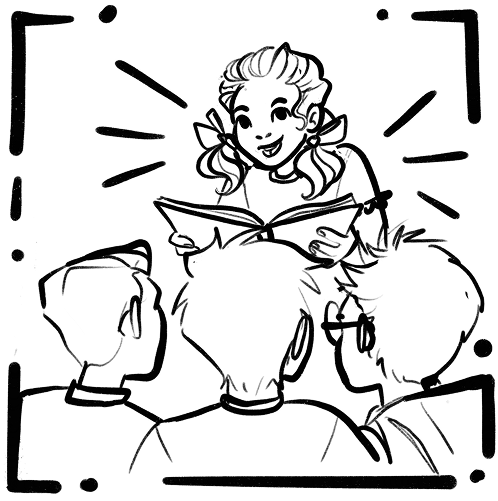
The girl looked sympathetically at the boy.
‘With the help of ciphers, women of that time could discuss with their friends their secret liaisons and keep diaries. This is another demonstration of what cryptography is good for – it gives people who understand the language of symbols some power and opens the door to a secret world where they can reveal anything they want.’
The buddies were silent for a moment. None of them dared to admit that they liked the idea of secret power very much, and at the same time, they were very upset at the thought of such a skill falling into the hands of women.
‘By the way,’ the girl said slyly, ‘When it came to love or contact with aliens, men also encrypted their messages in such a way that scientists are still unable to unravel them.’
‘And did they write a book about it with naked people too?’ The owner of the box asked snidely.
‘No,’ the girl replied nonchalantly, ‘they did it differently.’
Chapter Four. Dorabell’s Mystic Cipher
‘Once upon a time, an unknown musician named Edward Elgar made a confession – he was now a cipher composer! And all of that was due to the fact that his works, which he called “Enigma Variations” or “Variations on a Mysterious Theme”, hid the very real dark matter. He claimed that there was a key to all his variations – a certain composition which, when played simultaneously with his variations, sounded like a whole. Eduard Elgar never had time to tell anyone what that mysterious composition was.’
‘Way to prove it! Some weirdo. He thought he was some kind of encryption genius. Just like our Nim,’ the young man in short clothes interrupted the girl’s story.
‘I think it’s true,’ the quiet boy intervened, ‘It’s all about a letter, isn’t it?’
‘That’s true,’ nodded the girl, ‘Elgar loved riddles and ciphers, and one day he invented a cipher of his own, which is still undecipherable. This cipher went down in history as the Dorabella cipher and it was dedicated to a girl named Dora Penny. It all began simply – the composer’s family organized a reception where there were many guests, including a girl named Dora. Elgar enjoyed his time with the guests so much that he decided to thank each guest with a letter. Everyone who had been at the reception received letters with words of thanks and wishes of happiness, but only Dora received a card with the inscription “Miss Penny” on one side, and on the other side there was a text consisting of upside-down curlicues at different angles, similar to the number 3.’
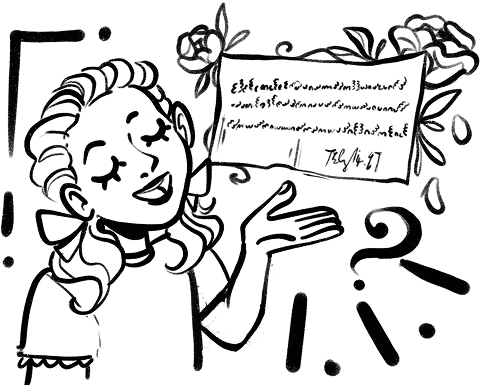
Nim straightened up sharply and rubbed his temples with his hands.
‘I’ve heard something about it,’ he said, ‘Dorabell’s cipher isn’t like a substitution cipher, or even a polyalphabetic cipher. It looks more like the writing of some extraterrestrial civilization.’
‘Sure it does,’ the short-clothed young man said with a hushed snicker, ‘The freak was into extraterrestrial civilizations, and even made up musical variations for them.’
‘And did nobody manage to decipher a single line of this message?’ – the modest friend interrupted the young man.
‘They managed to decipher something actually,’ the girl answered him. ‘The British literary scholar Eric Sams saw the following words in the message: “I own the darkness… EE sighs in separation… Why am I so sad, Belle… When I look at these roses, something dies inside me…..”. They couldn’t decipher the rest.’
‘And this text is questionable,’ the young man in the wrong sized clothes rejoined the conversation.
‘Dorabella’s message uses 88 symbols or infinity, so it’s probably about feelings, but can they be deciphered…? Who knows?’ Replied the girl coquettishly.
‘Please excuse me, but all this reminds me of some kind of horror movie,’ said the modest young man and crumpled a piece of paper with the drawn heart, ‘Three guys and one girl are sitting in a garage and solving the ciphers, which resemble alien messages. At one point, the garage door slams shut and the kids, having never gotten to the truth, are left there forever.’
‘Mystic, you say?’ Nim said, almost in a whisper, ‘What do you think of this, then?’
Chapter Five. The art house that came to life — the Voynich manuscript
Nim turned off the lights in the garage and held a lighted flashlight up to his face, making his face pale and the dark circles under his eyes made him look like a reanimated skeleton. Nim began to speak in a chant.
‘These images bring to mind an alchemical laboratory. People sitting in oddly shaped jars, a collection of outlandish plants, eerie images of naked people in glass rooms, women bathing in some green liquid. And this set of absurdity is accompanied by a text written in dense handwriting. The letters look very familiar, but upon detailed examination it turns out that they do not resemble anything. There are 240 pages in the book, but scientists are still struggling to unravel this manuscript.’
‘The Voynich manuscript,’ said the girl excitedly.
‘Exactly!’ confirmed Nim, surprised by her answer.
‘And who was this Voynich? Another weirdo who believed in aliens?’ asked the young man in clothes that didn’t fit him.
He decided to turn on the light and leave the garage door open, just in case. To be sure, he propped it open with his wooden crate: who knows what those coders would think of?
‘Voynich?’ Nim answered the question with a question. ‘He was an antiques dealer, not a scientist, not a weirdo, not even a cryptographer. They say he stumbled upon the manuscript in an old theological seminary during his trip to Rome. Inside, the book was full of unusual illustrations, ornate patterns and human figures that had been placed in glass tubes. And a letter written in the mid-seventeenth century by a Johann Marzi lay between the pages of the book. The letter said that the manuscript belonged to Emperor Rudolf II and then to the alchemist Georg Bareschka. That sounds like the truth.’
‘Some people who saw the manuscript believed that it was written by the philosopher Roger Bacon, others believed that it belonged to John Dee, a court sorcerer of Elizabeth I. And then there were theories about the manuscript’s existence. And then there were theories that the manuscript was of extraterrestrial origin.’
‘That’s what I said,’ the short guy shouted to his buddies and opened the garage door wide just in case.
‘What happened to the secret manuscript?’ asked his quiet friend, having nervously swallowed saliva.
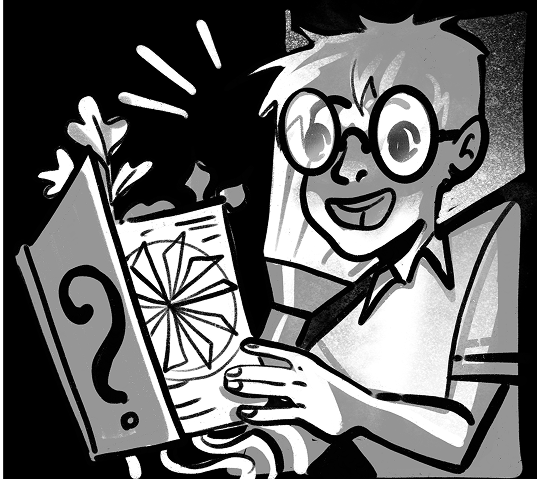
‘And then the most interesting thing began,’ Nim looked reproachfully at his friend, who was propping up an empty box on the garage door, ‘The manuscript fell into the hands of one of the best cryptographers in America William Friedman. He had already had to decipher messages from other languages, so he was eager to take on the interesting task. But no such luck, the manuscript wouldn’t budge. Friedman even created a circle of decipherers – they photographed the pages of the book and tried to write out each word letter by letter in order to use frequency analysis to identify service parts of speech and the most used vowels. But that didn’t help either. Then Friedman turned for help to another famous decipherer and scout John Tiltman. Together they searched for answers among the images drawn in the book, studied the plants that were depicted in the margins of the pages, and tried to decipher the manuscript with the help of known planned languages. Nothing. No patterns were revealed. And then, the manuscript parchment was examined by radiocarbon dating and the results showed that the manuscript was written between 1404 and 1438! So it can’t have been written by the philosophers Bacon and John Dee.
‘It’s very simple!’ Without moving away from the door shouted the guy in short clothes. ‘Voynich drew this manuscript himself. If he was engaged in antiques, then to get an old parchment for him was not a problem, and then there was a stormy flight of his imagination. Nothing new….’
‘There was indeed such a version,’ Nim agreed with his fellow, ‘And scientists are not in a hurry to discard it. Though I read that recently German Egyptologist Rainer Hanning studied this manuscript, confirmed its authenticity and revealed the assumption that each symbol written in the manuscript is an example of orthographic ligature, which was inherited from the times when one letter combined several sounds simultaneously.’
The silent young man looked around the garage – a ten-year-old boy in ill-fitting clothes was standing at the garage door, constantly adjusting an empty drawer; a girl was sitting at the table, looking like a Christmas doll and
‘Look, I don’t like all this,’ the young man admitted, ‘If encryption is a science, then why is it always associated with mysticism? Didn’t the scientists realize that behind every handwritten cipher there were people who could add something of their own, and that’s why their messages can’t be deciphered? Just like this heart drawn on the paper. The more we try to make sense of it, the further it gets away from us.
‘So, that’s the point,’ Nim supported his buddy, ‘Such ciphers were made by people, and people are led by one dynamic stereotype! This was even proved by the academician Pavlov. And if people are all the same, then the ciphers that were made by people can be solved.’
‘Do you want proof that cryptography exists?’ asked the girl, who had been silent until that moment, ‘Well, you’ll get it.’
Chapter six. The Bible.
‘What will you say to this?’ The girl put the Bible on the table.
‘Stop talking nonsense,’ the guy in the short clothes said grudgingly. He was tired of standing at the garage door, so he went inside and joined the guys, ‘Will you also tell me that the Bible has encrypted messages too?’
‘The Bible was written entirely in cipher. The Hebrew text of Scripture consisted of one continuous sequence of letters with no spaces between the words. The scientists had to choose a known Hebrew word, such as Yeshua or Jesus, and this was the first step in finding the code. The computer, which was loaded with the text of the scripture, then searched for all the letter sequences where these words occurred. This method of deciphering is called ELS – Equidistant Letter Sequence Search. Once the search was done, the computer listed all the places where that particular word occurs within a specified interval in the text. Next, the computer searched for related words to the keyword and so discovered secret messages. It is claimed that there are meaningfully paired names, dates and events that have been systematically hidden in the text. These messages can be found by reading the text forwards or backwards.’
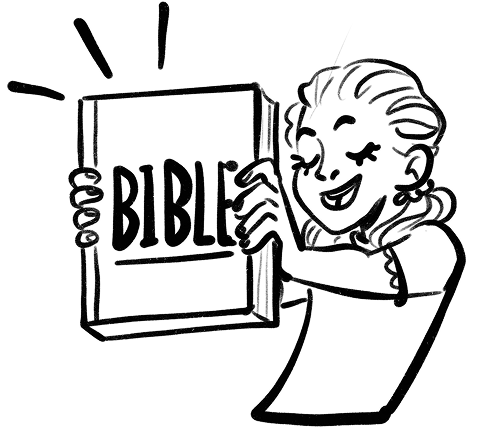
‘Yes?’ Nim jumped up from his seat, ‘And few people have ever wondered why the number of the beast is 666 and why the number 7 is often mentioned in the Bible! And, of course, few people know that the Bible uses asymmetric encryption!’
The quiet boy looked at his friends in surprise. The more he listened to them, the more it seemed to him that they were slowly going crazy.
‘Where did the beast come from in the Bible?’ he asked them cautiously.
‘That’s the question,’ Nim smiled, ‘In a nutshell, all these icons are codes, behind which there are hidden messages for people. Remember when we talked about how people used cryptography because it was dangerous to make certain things public? There are different methods of encryption used in the Bible, and one of them was an ancient method called gematria. Gematria is a cipher in which each letter is assigned a numerical value, such as Aleph: א = 1, Beth: ב = 2, Gimel: ג = 3, etc. This cipher was discovered by accident. When they began to compare the New and Old Testaments – in the New Testament the “number of the beast” was designated by the number 666, and in the Old Testament it was designated by the number 616. This prompted scientists to the idea that the numbers were assigned to different alphabets – Hebrew and ancient Hebrew. Using gematria, scientists deciphered the number 666 to learn the name of the bible beast and they found letters – Nron Qsr or Nro Qsr, that is the name of emperor Nero Caesar.’
‘Right!’ the girl intervened in the dialogue. ‘On this basis scientists put forward an assumption that the Bible actually describes the reality of that time. Those who wrote the sacred books saw Christians who fell into idolatry as ordinary apostates. Those who resisted temptation, on the contrary, should taste the bliss of paradise. The military power of Rome is behind the image of the beast, the beast that came out of the earth is the cult of the emperor, and the Harlot of Babylon is the Roman Empire itself.’
The buddies fell silent. The Bible, a book familiar to everyone since childhood, also turned out to be a coded message.
‘And why has a metallophone been here all the time?’ the young man in short clothes suddenly asked.
Chapter seven. Write to me in sheet music
He placed the metallophone in his lap and began to play. The melody was harmonious: Nim clapped his hands happily to the music, and his quiet friend asked the girl for a dance.
When the music stopped, the satisfied friends exhaled happily.
‘I don’t need to tell you that music is all about cryptography, do I?” Nim asked gently.
‘Alright, alright, tell us,’ the short guy asked favorably, ‘Notes are just like letters for musicians, which can be put together in a certain sequence to form a melody. And the melody then conveys the meaning. Have I got that right? By the way, there are only seven notes, just like the seven seals in the Bible… Stop.’
‘Wow, you’ve just solved the secret code and discovered a close connection between a person’s predisposition to decoding and his musical abilities,’ laughed the girl, ‘Then you surely know that Johann Sebastian Bach hid his last name behind the notes B-flat, A, C, B (B-A-C-H)?’
‘And surely you know that Johannes Brahms, in his String Sextet No. 2, often used a combination of AGAHE notes to convey his feelings for his lover Agatha?’ Nim also decided to play a prank on a friend.
The guy in the short clothes frowned and headed for the garage exit.
‘I know everything,’ he turned around and told his friends, ‘I know that the musical figures that composers used are actually sound formulas, elements of speech, vocabulary, to put it simply. For example, the chromatic movement within a quarta, an interval of four sounds, is a symbol of grief and suffering. The descending seconds joined in pairs is a symbol of sighing and mourning. Because they mimic conversational intonation, conveying a question, a sigh, or an exclamation. A particular tune can even reproduce a gesture, a physical movement: a step, a move up or down.’
The friends looked at the young man with admiration. And he, without paying any attention to them, continued.
‘Even tonalities have their own semantics: D major expressed “noisy” emotions, bravura, E-flat major with its three bemolts was associated by musicians with trinity, G major was used by Johann Sebastian Bach to express joy. Tessitura (pitch) served to denote musical space and direction of movement. High sound corresponded to the heavenly spheres, while low sound corresponded to the abysses, the plunge into the underworld. The middle range symbolized earthly, human space. And Bach did not use the theme of the cross only to encode his surname. If you look carefully in the notes, you can see that the leitmotif will be repeated 4 times in the work – in the upper register, in the lower register, then it will pass from one hand to another and will be repeated in the mirror writing. Pure math.’
The boy finished and took an empty box, which he used to prop up the door.
‘Wait,’ the girl stopped him, ‘Why do you always carry that empty box around with you?’
‘Because you all forgot that I play the cello, and it weighs 10 kilograms. So I spend my free time practicing with the box. You should communicate with people, talk to them, but not send them coded messages.’
The young man wearing short clothes left the garage. Nim ran out after him and held the door for the girl.
The quiet young man looked at the crumpled piece of paper again. As he had carried the piece of paper with the drawn heart with him all day, the edges of the paper were frayed and gray, and the message clearly showed the fingerprints of his fellows. And only the scarlet heart, with a neatly painted outline remained in place and reminded the young man that the main riddles are still ahead.
‘I’ll send her the same heart in return. Now it’s her turn to unravel its meaning with the help of cryptography,’ the young man muttered and left the garage.
Is there life on Mars, or is there no life on Mars? Join the eternal debate on paradoxes!
Thank you!


